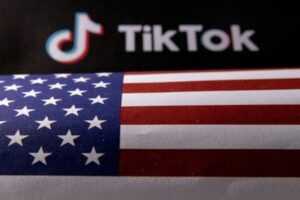By Gertrude Chavez-Dreyfuss
NEW YORK (Reuters) – Options on Secured Overnight Financing Rate (SOFR) futures are showing a higher probability that the Federal Reserve could hike interest rates a quarter percentage point this year and next as U.S. inflation and the labor market remain resilient.
Bond investors look to SOFR futures, among other indicators, to gauge expectations on Fed policy rates. Options, on the other hand, are widely used to hedge against expected moves, with “vol” or volatility a key input in the price.
SOFR, currently at 5.31%, measures the cost of borrowing cash overnight in money markets collateralized by U.S. Treasuries. It is the benchmark rate used to price dollar-denominated derivatives and loans.
Odds for a rise in SOFR are low, though not insignificant. Few market participants actually expect the Fed to hike again. It could well be that the Fed cuts rates just once this year or not at all, and hold them higher for longer.
Analysts said it would take a full-blown re-acceleration in inflation for the Fed to tighten again. That is not the baseline scenario for most economists.
Inflation remains stubborn despite slowing late last year after 15 months of aggressive rate hikes that the Fed halted in July. Data on Thursday showed that core U.S. personal consumption expenditures inflation rose 3.7% in the first quarter, after growing 2% in the fourth.
Friday’s monthly report on PCE inflation for March showed 0.3% growth, the same as February, while over 12 months inflation rose 2.7%, worse than February’s 2.5% and further from the Fed’s 2% target.
“If you look purely at the data and you did not have the rhetoric coming from central banks, we would be pricing in hikes, not cuts,” said Akshay Singal, head of short-term interest rate trading at Citi.
“And the fact that central bankers have been of the view that they’ve done enough is being challenged quite aggressively now.”
The option-implied probability for SOFR to rise 25 basis points to 5.56% by December has risen to 29%, Barclays estimates showed, from about 26% in early April.
The prospect of a no-cut scenario for 2024 is 31%, up from 20% a month ago, BNP Paribas data showed. Chances of the first 25-bp hike in 2025 are at 22%. Volume though is typically thin the further out the curve so that number can change.
Gennadiy Goldberg, head of U.S. rates strategy at TD Securities, said the increase in pricing reflects the uncertainty investors face in an environment of strong growth and persistent inflation.
“The longer we stay at higher rates and the economy stays strong and inflation sticky, the more investors will question whether the Fed is doing enough,” he added.
MARKET BIASED TOWARD CUTS
Even so, SOFR futures have priced in about 30 basis points in easing for 2024.
“There’s a very high threshold to price a shift in Fed policy,” said Bruno Braizinha, rates strategist at BofA Securities. “U.S. data needs to improve by a lot for the market to abandon rate cuts and transition to pricing hikes.”
The rise in implied volatility in interest rate swaps, a corner in the fixed income space investors use to hedge interest rate risk, has accompanied the increase in rate-hike odds with rising uncertainty over Fed outcomes.
Rate swaps measure the cost of exchanging fixed-rate cash flows for floating-rate ones, or vice versa.
Implied vol is a gauge of how much the option market believes rate swaps will move in either direction over a given time frame. The higher the vol, the greater the perceived instability over a given period.
Volatility on shorter-dated swaptions such as one-year at-the-money options on one-year swap rates, that part of the curve in which Fed policy is being priced, rose to a price of 28.62 bps on Thursday, the highest since April 17.
So-called receiver swaptions, a type of option that pays off when interest rates fall, are still in demand. In a receiver swaption, the holder of the option chooses to pay a fixed interest rate in exchange for receiving a floating rate.
But the price for those receivers have cheapened a bit on shorter maturities, suggesting that demand may be easing as rate cuts are factored out.
“The baseline case for now is no-landing,” BofA’s Braizinha said, referring to a scenario where the U.S. economy avoids recession. And that, he said, does not necessarily warrant a rate hike.
(Reporting by Gertrude Chavez-Dreyfuss; Additional reporting by Laura Matthews; Editing by Alden Bentley and Richard Chang)





